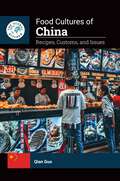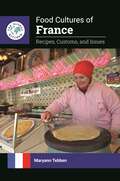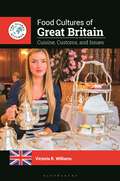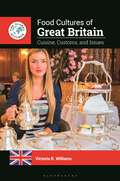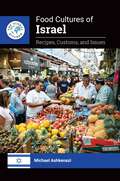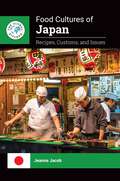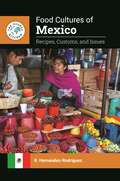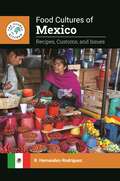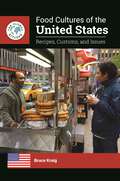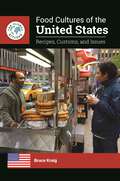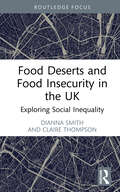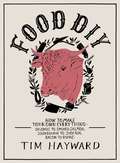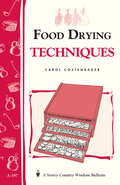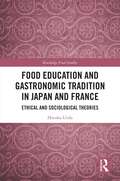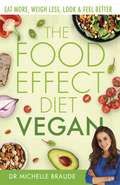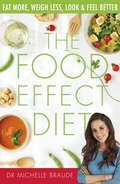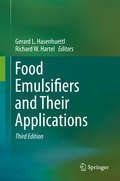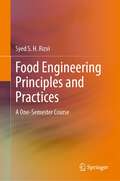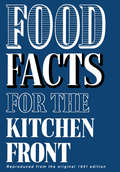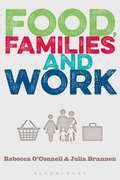- Table View
- List View
Food Cultures of China: Recipes, Customs, and Issues (The Global Kitchen)
by Qian GuoExploring the rich and varied culinary traditions of China, this book enables a better understanding of Chinese history and culture through food.Part of Bloomsbury's Global Kitchen series, this book takes readers on a food tour of China, covering everything from daily staples to holiday specialties. In addition to discovering China's long culinary history, you'll learn about recent trends, foreign influences, and contemporary food and dietary concerns, such as obesity and environmental sustainability.Chapters are organized thematically, making it easy to focus in on particular courses or types of dishes. For those hungry for a more hands-on approach, each chapter includes a collection of accessible recipes that allow readers to bring the subject to life in their own kitchens. The main text is supplemented by sidebars that offer interesting bite-sized facts, a chronology of important dates in China's culinary history, and a glossary of key food- and dining-related terms. Sun Yat-sen, the founding father of modern China, asserted that China's food culture was the most advanced and sophisticated in the world, despite the country lagging the West in science, industry, and civic engagement. Today, many people outside China immediately envision iconic dishes like fried rice, egg rolls, or sweet and sour pork when they think of Chinese food. But China has a much richer and more diverse set of culinary traditions. China's food culture is one of the oldest in the world, evolving over thousands of years. It has been shaped by a myriad of forces, from historical struggles with food insecurity to the modern push toward speed and convenience. Across this large nation, unique cuisines emerged that reflect the varied geography, climate, and customs of different regions.
Food Cultures of France: Recipes, Customs, and Issues (The Global Kitchen)
by Maryann TebbenAs a comprehensive overview of French food from fine dining to street food and from Roman Gaul to current trends, this book offers anyone with an interest in French cuisine a readable guide to the country and its customs.In France, food is integral to the culture. From the Revolutionary cry for good bread at a fair price to the current embrace of American bagels and "French tacos," this book tells the full story of French food.Food Cultures of France: Recipes, Customs, and Issues explores the highs and lows of French cuisine, with examples taken from every historical era and all corners of France. Readers can discover crêpes from Brittany; fish dumplings from Lyon; the gastronomic heights of Parisian restaurant cuisine; glimpses of the cuisines of France's overseas territories in Africa and the Caribbean; and the impact of immigrant communities on the future of French food. Learn how the geography of France shaped the diet of its people and which dishes have withstood the test of time. Whether the reader knows all about French cuisine or has never tasted a croissant, this book will offer new insights and delicious details about French food in all its forms.
Food Cultures of France: Recipes, Customs, and Issues (The Global Kitchen)
by Maryann TebbenAs a comprehensive overview of French food from fine dining to street food and from Roman Gaul to current trends, this book offers anyone with an interest in French cuisine a readable guide to the country and its customs.In France, food is integral to the culture. From the Revolutionary cry for good bread at a fair price to the current embrace of American bagels and "French tacos," this book tells the full story of French food.Food Cultures of France: Recipes, Customs, and Issues explores the highs and lows of French cuisine, with examples taken from every historical era and all corners of France. Readers can discover crêpes from Brittany; fish dumplings from Lyon; the gastronomic heights of Parisian restaurant cuisine; glimpses of the cuisines of France's overseas territories in Africa and the Caribbean; and the impact of immigrant communities on the future of French food. Learn how the geography of France shaped the diet of its people and which dishes have withstood the test of time. Whether the reader knows all about French cuisine or has never tasted a croissant, this book will offer new insights and delicious details about French food in all its forms.
Food Cultures of Great Britain: Cuisine, Customs, and Issues (The Global Kitchen)
by Victoria R. WilliamsThere's far more to British food than fish and chips. Discover the history and culture of Great Britain through its rich culinary traditions.Part of the Global Kitchen series, this book takes readers on a food tour of Great Britain, covering everything from daily staples to holiday specialties. In addition to discovering Great Britain's long culinary history, you'll learn about recent trends, foreign influences, and contemporary food and dietary concerns, such as obesity and the impacts of climate change. Chapters are organized thematically, making it easy to focus in on particular courses or types of dishes. The main text is supplemented by sidebars that offer interesting bite-sized facts, a chronology of important dates in British culinary history, and a glossary of key food- and dining-related terms.When people outside Great Britain think of British cuisine, they likely envision iconic foods and traditions such as fish and chips, a full English breakfast, and afternoon tea. But Great Britain has a much richer and more diverse culinary history. It has been shaped by a myriad of events, from invasions by the Romans, Vikings, and Normans to the emergence and expansion of the British Empire to the privations of World War II. In more recent times, Great Britain's departure from the European Union, the global Covid-19 pandemic, and Russia's invasion of Ukraine have all had a significant impact on the food landscape of Great Britain.
Food Cultures of Great Britain: Cuisine, Customs, and Issues (The Global Kitchen)
by Victoria R. WilliamsThere's far more to British food than fish and chips. Discover the history and culture of Great Britain through its rich culinary traditions.Part of the Global Kitchen series, this book takes readers on a food tour of Great Britain, covering everything from daily staples to holiday specialties. In addition to discovering Great Britain's long culinary history, you'll learn about recent trends, foreign influences, and contemporary food and dietary concerns, such as obesity and the impacts of climate change. Chapters are organized thematically, making it easy to focus in on particular courses or types of dishes. The main text is supplemented by sidebars that offer interesting bite-sized facts, a chronology of important dates in British culinary history, and a glossary of key food- and dining-related terms.When people outside Great Britain think of British cuisine, they likely envision iconic foods and traditions such as fish and chips, a full English breakfast, and afternoon tea. But Great Britain has a much richer and more diverse culinary history. It has been shaped by a myriad of events, from invasions by the Romans, Vikings, and Normans to the emergence and expansion of the British Empire to the privations of World War II. In more recent times, Great Britain's departure from the European Union, the global Covid-19 pandemic, and Russia's invasion of Ukraine have all had a significant impact on the food landscape of Great Britain.
Food Cultures of Israel: Recipes, Customs, and Issues (The Global Kitchen)
by Michael AshkenaziThis volume explores cuisine in Israel, including the country's food culture history, important dishes, current food issues, and more.The evolution of Israeli food has been dependent on three major variables: the geography and climate of Israel, its ethnic mix and ethnic history (including religious influences, non-Jewish communities, and heavy immigration from around the world), and technical innovation that has enabled Israel to become a leader in agricultural technology.This book provides a comprehensive picture of Israeli food culture in the twenty-first century, examined on the basis of the various influences that created this particular culture. Such influences include the lengthy food history that can be traced to prehistory, including data from the Bible and Koran and archaeological evidence; as well as contemporary food practices that have emerged as a mix of influences from different ethnic groups. Modern Israeli food practices are the result of the sway of European, Middle Eastern, and other cultures, creating a cuisine that is marked by its blends. Main topics are accompanied by easy-to-follow recipes. The book serves as an introduction to daily life in Israel as well as the evolution of food practices in a relatively new country.
Food Cultures of Israel: Recipes, Customs, and Issues (The Global Kitchen)
by Michael AshkenaziThis volume explores cuisine in Israel, including the country's food culture history, important dishes, current food issues, and more.The evolution of Israeli food has been dependent on three major variables: the geography and climate of Israel, its ethnic mix and ethnic history (including religious influences, non-Jewish communities, and heavy immigration from around the world), and technical innovation that has enabled Israel to become a leader in agricultural technology.This book provides a comprehensive picture of Israeli food culture in the twenty-first century, examined on the basis of the various influences that created this particular culture. Such influences include the lengthy food history that can be traced to prehistory, including data from the Bible and Koran and archaeological evidence; as well as contemporary food practices that have emerged as a mix of influences from different ethnic groups. Modern Israeli food practices are the result of the sway of European, Middle Eastern, and other cultures, creating a cuisine that is marked by its blends. Main topics are accompanied by easy-to-follow recipes. The book serves as an introduction to daily life in Israel as well as the evolution of food practices in a relatively new country.
Food Cultures of Japan: Recipes, Customs, and Issues (The Global Kitchen)
by Jeanne JacobThis addition to the Global Kitchen series explores the cuisine of Japan, from culinary history and important ingredients to essential daily and special meals.When we think of Japanese food in the United States, certain images come to mind: sushi, ramen, and hibachi restaurants. But what is food like in this island nation? What do people eat and drink every day? Are food concerns similar to those in the United States, where obesity is a major issue?This volume offers comprehensive coverage on the cuisine of Japan. Readers will learn about the history of food in the country, influential ingredients that play an important role in daily cooking and consumption, meals and dishes for every occasion, and what food is like when dining out or stopping for snacks from street vendors. An additional chapter examines food issues and dietary concerns. Recipes accompany every chapter. A chronology, glossary, sidebars, and bibliography round out the work.
Food Cultures of Japan: Recipes, Customs, and Issues (The Global Kitchen)
by Jeanne JacobThis addition to the Global Kitchen series explores the cuisine of Japan, from culinary history and important ingredients to essential daily and special meals.When we think of Japanese food in the United States, certain images come to mind: sushi, ramen, and hibachi restaurants. But what is food like in this island nation? What do people eat and drink every day? Are food concerns similar to those in the United States, where obesity is a major issue?This volume offers comprehensive coverage on the cuisine of Japan. Readers will learn about the history of food in the country, influential ingredients that play an important role in daily cooking and consumption, meals and dishes for every occasion, and what food is like when dining out or stopping for snacks from street vendors. An additional chapter examines food issues and dietary concerns. Recipes accompany every chapter. A chronology, glossary, sidebars, and bibliography round out the work.
Food Cultures of Mexico: Recipes, Customs, and Issues (The Global Kitchen)
by R. Hernandez-RodriguezThis exciting volume brings to life the food culture of Mexico, detailing the development of the cuisine and providing practical information about ingredients and cooking techniques so that readers can replicate some of Mexico's most important traditional dishes.Mexican food has become one of the most popular cuisines in the United States, with noted dishes ranging from tacos and enchiladas to tamales and guacamole. What are the origins of Mexican food culture as we know it today?Written with an educated—not specialized—audience in mind, the book includes descriptions of traditional and high cuisine, regional and national foods, everyday dishes and those prepared and served on holidays and special occasions. It also discusses ancestral eating habits and the way the food has been transformed under the pressures of globalization.Specific chapters examine food history, important ingredients, typical appetizers, main meals, desserts, street foods and snacks, dining out, and food issues and dietary concerns. Recipes accompany every chapter. Rounding out the work are a chronology of food history, a glossary, sidebars, and a bibliography. This volume is ideal for any students learning about Mexican food and culture, as well as general readers who would like to learn more about international cuisines.
Food Cultures of Mexico: Recipes, Customs, and Issues (The Global Kitchen)
by R. Hernandez-RodriguezThis exciting volume brings to life the food culture of Mexico, detailing the development of the cuisine and providing practical information about ingredients and cooking techniques so that readers can replicate some of Mexico's most important traditional dishes.Mexican food has become one of the most popular cuisines in the United States, with noted dishes ranging from tacos and enchiladas to tamales and guacamole. What are the origins of Mexican food culture as we know it today?Written with an educated—not specialized—audience in mind, the book includes descriptions of traditional and high cuisine, regional and national foods, everyday dishes and those prepared and served on holidays and special occasions. It also discusses ancestral eating habits and the way the food has been transformed under the pressures of globalization.Specific chapters examine food history, important ingredients, typical appetizers, main meals, desserts, street foods and snacks, dining out, and food issues and dietary concerns. Recipes accompany every chapter. Rounding out the work are a chronology of food history, a glossary, sidebars, and a bibliography. This volume is ideal for any students learning about Mexican food and culture, as well as general readers who would like to learn more about international cuisines.
Food Cultures of the United States: Recipes, Customs, and Issues (The Global Kitchen)
by Bruce KraigThis comprehensive volume examines the history of American food culture and cuisine today, from staple ingredients to dietary concerns.Everyday, without realizing it, Americans plan their days around food—what to make for dinner, where to meet for brunch, what to bring to a party. As a nation of immigrants, the U.S. has food and foodways that few countries in the world have. This addition to the Global Kitchen series examines all aspects of food culture in the United States, from the early Colonial period and Native American influences on the new immigrants' food to the modern era.The volume opens with a Chronology that looks at United States history and significant food events. Coverage then dives deep into the history of food in the U.S., and is followed by a chapter on influential ingredients in American cooking. Chapters break down American cuisine into appetizers and side dishes, main dishes, and desserts, looking at typical meals and flavors that characterize it. Additional chapters examine food eaten during holidays and on special occasions, street food and snacks, and restauarants. A final chapter looks at issues and dietary concerns. Recipes round out each chapter.
Food Cultures of the United States: Recipes, Customs, and Issues (The Global Kitchen)
by Bruce KraigThis comprehensive volume examines the history of American food culture and cuisine today, from staple ingredients to dietary concerns.Everyday, without realizing it, Americans plan their days around food—what to make for dinner, where to meet for brunch, what to bring to a party. As a nation of immigrants, the U.S. has food and foodways that few countries in the world have. This addition to the Global Kitchen series examines all aspects of food culture in the United States, from the early Colonial period and Native American influences on the new immigrants' food to the modern era.The volume opens with a Chronology that looks at United States history and significant food events. Coverage then dives deep into the history of food in the U.S., and is followed by a chapter on influential ingredients in American cooking. Chapters break down American cuisine into appetizers and side dishes, main dishes, and desserts, looking at typical meals and flavors that characterize it. Additional chapters examine food eaten during holidays and on special occasions, street food and snacks, and restauarants. A final chapter looks at issues and dietary concerns. Recipes round out each chapter.
Food Deserts and Food Insecurity in the UK: Exploring Social Inequality (Routledge Focus on Environment and Sustainability)
by Dianna Smith Claire ThompsonThis book examines the social inequalities relating to food insecurity in the UK, as well as drawing parallels with the US. Access to food in the UK, and especially access to healthy food, is a constant source of worry for many in this wealthy country. Crises, such as the COVID-19 pandemic, have coincided with a steep rise in the cost of living, meaning household food insecurity has become a reality for many more households. This book introduces a new framework to examine the many influences on local-level food inequalities, whether they result from individual circumstances or where a person lives. The framework will allow researchers new to the field to consider the many influences on food security, and to support emerging research around different sub-topics of food access and food security. Providing a thorough background to two key concepts, food deserts and food insecurity, the book documents the transition from area-based framing of food resources, to approaches which focus on household food poverty and the rise of food banks. The book invites researchers to acknowledge and explore the ever changing range of place-based factors that shape experiences of food insecurity: from transport and employment to rural isolation and local politics. By proposing a new framework for food insecurity research and by drawing on real-world examples, this book will support academic and applied researchers as they work to understand and mitigate the impacts of food insecurity in local communities. This book will be of great interest to students and scholars of food and nutrition security, public health, and sociology. It will also appeal to food policy professionals and policymakers who are working to address social inequalities and improve access to healthy and nutritious food for all.
Food Deserts and Food Insecurity in the UK: Exploring Social Inequality (Routledge Focus on Environment and Sustainability)
by Dianna Smith Claire ThompsonThis book examines the social inequalities relating to food insecurity in the UK, as well as drawing parallels with the US. Access to food in the UK, and especially access to healthy food, is a constant source of worry for many in this wealthy country. Crises, such as the COVID-19 pandemic, have coincided with a steep rise in the cost of living, meaning household food insecurity has become a reality for many more households. This book introduces a new framework to examine the many influences on local-level food inequalities, whether they result from individual circumstances or where a person lives. The framework will allow researchers new to the field to consider the many influences on food security, and to support emerging research around different sub-topics of food access and food security. Providing a thorough background to two key concepts, food deserts and food insecurity, the book documents the transition from area-based framing of food resources, to approaches which focus on household food poverty and the rise of food banks. The book invites researchers to acknowledge and explore the ever changing range of place-based factors that shape experiences of food insecurity: from transport and employment to rural isolation and local politics. By proposing a new framework for food insecurity research and by drawing on real-world examples, this book will support academic and applied researchers as they work to understand and mitigate the impacts of food insecurity in local communities. This book will be of great interest to students and scholars of food and nutrition security, public health, and sociology. It will also appeal to food policy professionals and policymakers who are working to address social inequalities and improve access to healthy and nutritious food for all.
Food DIY: How to Make Your Own Everything: sausages to smoked salmon, sourdough to sloe gin, bacon to buns
by Tim Hayward'Warning: contains tantalising graphic depictions of meat' Esquire'This is a tome to splatter through constant use' Harper's BazaarTim Hayward's Food DIY - the first comprehensive manual for the DIY cook.Over recent years, across much of the world, people have started rejecting shop bought food and are getting into making it themselves. The DIY food movement is spreading.But why DIY? Because it's fun, an adventure, thrifty, a great way to get your hands gloriously dirty, and because at a time when skills like baking, preserving and curing are in danger of being lost forever, it's more important than ever to learn how things work. Most importantly though, when you do it yourself you can make sure that all the food you eat is absolutely delicious.In Food DIY, Tim Hayward, editor of influential food magazine Fire & Knives and enthusiastic DIYer, will show you:- How to make your own butter and cheese, sloe gin, suet pudding and potted lobster.- How to smoke, and cure fish and meats, air-dry bresaola and boerwoers, as well aspickle fish, game and vegetables.- He'll explain the mysteries of terrines and faggots, bread and buns, as well how to spit-roast a whole lamb, make a clam bake in a wheelbarrow, smoke a salmon in a gym locker and deep fry a turkey outdoors.- He'll teach you how to make your own takeaway: from delicious Peking duck and fried chicken to doner kebab and your morning cappuccino.'The perfect guide to everything from salt beef to gravadlax, through jerkey, pickles and sloe gin' Shortlist'If you fantasise over the perfect pork pie with a proper jelly layer and cut into each deli-bought version only to be disappointed, here is the answer' Independent'If you like Cooked, and even if you didn't, check out Tim Hayward's new book, which promises to be a DIY classic' Michael Pollan'As 'Urban Food DIY-er' Tim Hayward proves with his new book, making your own everything is much easier than you might think and a whole lot of fun . . . excellent inspiration for anyone who cherishes the art of producing good food' Psychologies
Food Drying Techniques: Storey's Country Wisdom Bulletin A-197 (Storey Country Wisdom Bulletin)
by Carol W. CostenbaderSince 1973, Storey's Country Wisdom Bulletins have offered practical, hands-on instructions designed to help readers master dozens of country living skills quickly and easily. There are now more than 170 titles in this series, and their remarkable popularity reflects the common desire of country and city dwellers alike to cultivate personal independence in everyday life.
Food Education and Gastronomic Tradition in Japan and France: Ethical and Sociological Theories (Routledge Food Studies)
by Haruka UedaDrawing on ethical and sociological theories of food, this book presents a new approach to food education that moves beyond nutrition-centred education. Food education has gained increasing scientific and political importance in many countries as a promising way to change contemporary eating. However, many practices fail to address two epistemological obstacles regarding its very components – ‘food’ and ‘education’. Food has largely been thought of from a nutritionistic viewpoint alone and the ethical issues over children’s freedom of choice and well-being have been absent. This book resolves these problems by applying ethical and sociological theories of food and analysing food education in two pioneering countries: Japan and France. The book focuses on taste education and gastronomy as two key concepts which have great potential to positively impact food education. Taste education is a promising alternative to nutrition-centred pedagogy which foregrounds the experience and pleasure of eating food, creating an environment for taste sensibility and food curiosity. From taste education, the picture can be broadened to examine the role and impact of gastronomy in food education. Examining the cultural traditions of France and Japan reveals how gastronomy can impact eating habits and food cultures and how these criteria should be an intrinsic part of food education. The book concludes by constructing an integrative theory for food education that moves beyond nutrition-centred education for the benefit of one’s well-being. This book will greatly interest students, scholars, policymakers and educators working on food education, food-related issues at the intersection between nutritional and social sciences, and ‘gastronomes’ searching for a pedagogical guide for developing their capabilities to eat in a more humanistic way.
Food Education and Gastronomic Tradition in Japan and France: Ethical and Sociological Theories (Routledge Food Studies)
by Haruka UedaDrawing on ethical and sociological theories of food, this book presents a new approach to food education that moves beyond nutrition-centred education. Food education has gained increasing scientific and political importance in many countries as a promising way to change contemporary eating. However, many practices fail to address two epistemological obstacles regarding its very components – ‘food’ and ‘education’. Food has largely been thought of from a nutritionistic viewpoint alone and the ethical issues over children’s freedom of choice and well-being have been absent. This book resolves these problems by applying ethical and sociological theories of food and analysing food education in two pioneering countries: Japan and France. The book focuses on taste education and gastronomy as two key concepts which have great potential to positively impact food education. Taste education is a promising alternative to nutrition-centred pedagogy which foregrounds the experience and pleasure of eating food, creating an environment for taste sensibility and food curiosity. From taste education, the picture can be broadened to examine the role and impact of gastronomy in food education. Examining the cultural traditions of France and Japan reveals how gastronomy can impact eating habits and food cultures and how these criteria should be an intrinsic part of food education. The book concludes by constructing an integrative theory for food education that moves beyond nutrition-centred education for the benefit of one’s well-being. This book will greatly interest students, scholars, policymakers and educators working on food education, food-related issues at the intersection between nutritional and social sciences, and ‘gastronomes’ searching for a pedagogical guide for developing their capabilities to eat in a more humanistic way.
The Food Effect Diet: Eat More, Weigh Less, Look & Feel Better
by Dr Michelle BraudeDitch the complicated recipes, expensive products and supplements, vegan 'detoxes' and all the other crazes out there - that's the message of The Food Effect approach to nutrition - which, based on real science, separates the fads from the facts, and now presents the program that's had amazing results, adapted to suit a vegan diet. Set to teach the simple secrets to long-term practical success for weight loss for vegans, The Food Effect Diet: Vegan is a simple, delicious, satisfying way of eating that sheds weight, boosts energy, lowers cholesterol and blood pressure, and also gives glowing skin, increased brain power and optimal health and vitality. Simple and effective without over-complicating, The Food Effect Diet Vegan delivers a painless and proven way to achieve your weight loss goals and get you on the road to optimal health, all whilst following a vegan lifestyle easily and enjoyably.The Food Effect Diet: Vegan will include:*A wide array of vegan food choices, including surprising sources of 'good for you' carbs and proteins.*Menu options for breakfast, lunch, dinner and snacks based on a variety of taste preferences, lifestyles and nutritional needs.*More than 65 delicious and easy vegan recipes, plus a complete set of simple meal ideas for those who don't like, or don't have time, to cook.*Dietary recommendations - designed with a calorie cap to ensure you achieve your weight loss goals.*Guidance on which supplements to take to ensure all nutritional needs are met.
The Food Effect Diet: Eat More, Weigh Less, Look and Feel Better
by Dr Michelle BraudeAS SEEN IN THE TIMES.LOSE AT LEAST 6LBS IN FOUR WEEKS WITHOUT GIVING UP CARBS, ALCOHOL OR CHOCOLATEThe Food Effect Diet is a simple, delicious and satisfying way of eating that sheds weight, boosts energy, lowers cholesterol and blood pressure. It also gives you glowing skin, increased brain power and optimal health and vitality.A perfect antidote to faddy, restrictive crash diets that don't work over the long-term, The Food Effect Diet promises a minimum weight loss of 6lbs in four weeks, while allowing you to eat carbs, good fats, wheat, gluten and dairy. Followers of the diet can also drink alcohol and eat chocolate - the only significant 'no no' is red meat.As well as a detailed programme for the four-week 'attack' phase, the book will include menu plans which can be adapted to suit different taste preferences, lifestyles and nutritional needs; over 70 delicious and easy recipes; and easy-to-follow food tables to guide your choices for each food group.
Food Emulsifiers and Their Applications
by Gerard L. Hasenhuettl Richard W. HartelEmulsifiers, also known as surfactants, are often added to processed foods to improve stability, texture, or shelf life. These additives are regulated by national agencies, such as the FDA, or multi-national authorities, such as the EEC or WHO. The amphiphilic molecules function by assisting the dispersion of mutually insoluble phases and stabilizing the resulting colloids, emulsions, and foams. Emulsifiers can interact with other food components such as carbohydrates, proteins, water, and ions to produce complexes and mesophases. These interactions may enhance or disrupt structures and affect functional properties of finished foods. In dairy processing, small molecule emulsifiers may displace dairy proteins from oil/water and air/water interfaces, which affects stability and properties of the foams and emulsions. In baked products, emulsifiers contribute to secondary functionalities, such as dough strengthening and anti-staling. Synthetic food emulsifiers suffer from the stigma of chemical names on a product’s ingredient statement. Modern consumers are seeking products that are “all natural.” Fortunately, there are a number of natural ingredients that are surface-active, such as lecithin, milk proteins, and some protein-containing hydrocolloids. Mayonnaise, for example, is stabilized by egg yolk. This book can serve as both a guide for professionals in the food industry to provide an understanding of emulsifier functionality, and a stimulus for further innovation. Students of food science will find this to be a valuable resource.
Food Engineering Principles and Practices: A One-Semester Course
by Syed S. RizviThis textbook is designed for a one-semester course on Food Engineering, and it offers a concise, in-depth and integrated introduction to the fundamental engineering and physicochemical principles and practices of utility in food processing and manufacturing operations. The textbook includes topics mandated by the Institute of Food Technologists for accreditation of Food Science curricula and helps prepare the students better for taking advance courses related to unit operations in food manufacturing. It is also relevant for Food Process Engineering courses, containing materials that most instructors can cover in three semester hours of instruction. In the first three chapters, readers will find an overview of the basic knowledge of physics and chemistry and an introduction to the engineering language needed to eliminate confusion going forward. In the following chapters, the author covers the main concepts of food thermodynamics, heat transfer–radiation in foodmaterials, mass transfer and fluid dynamics in food, along with real-life examples and exercises to help students relate better to the topics. The author also gives a brief introduction to the main mathematical and analytical concepts required in food engineering.This textbook equips readers to understand a diversity of food engineering related topics and each chapter is enriched with practical examples and Check Your Understanding sections, as well as several problems. The textbook is aimed at undergraduate food science students in their first required introductory food engineering course, but practitioners involved in designing, optimizing, and managing the processing of food products will also find it a useful account.
Food Facts for the Kitchen Front
by HarperPressThe perfect gift for yourself or someone else, this classy reproduction of a 1940's cooking manual combines time-tested wisdom with practical, no-nonsense recipes.
Food, Families and Work
by Rebecca O'Connell Julia BrannenWith dual-working households now the norm, Food, Families and Work is the first comprehensive study to explore how families negotiate everyday food practices in the context of paid employment.As the working hours of British parents are among the highest in Europe, the United Kingdom provides a key case study for investigating the relationship between parental employment and family food practices. Focusing on issues such as the gender division of foodwork, the impact of family income on diet, family meals, and the power children wield over the food they eat, the book offers a longitudinal view of family routines. It explores how the everyday meanings of food change as children grow older and negotiate changes in their own lives and those of their family members. Drawing on extensive quantitative data from large-scale surveys of food and diet – as well as qualitative evidence – to emphasise the larger global context of social and economic change and shifting patterns of family life, Rebecca O'Connell and Julia Brannen present a holistic overview of food practices within busy contemporary family lives. Featuring perspectives from both parents and children, this innovative approach to some of the most hotly-debated topics in food studies is a must-read for students and scholars in food studies, sociology, anthropology, nutrition and public health.
